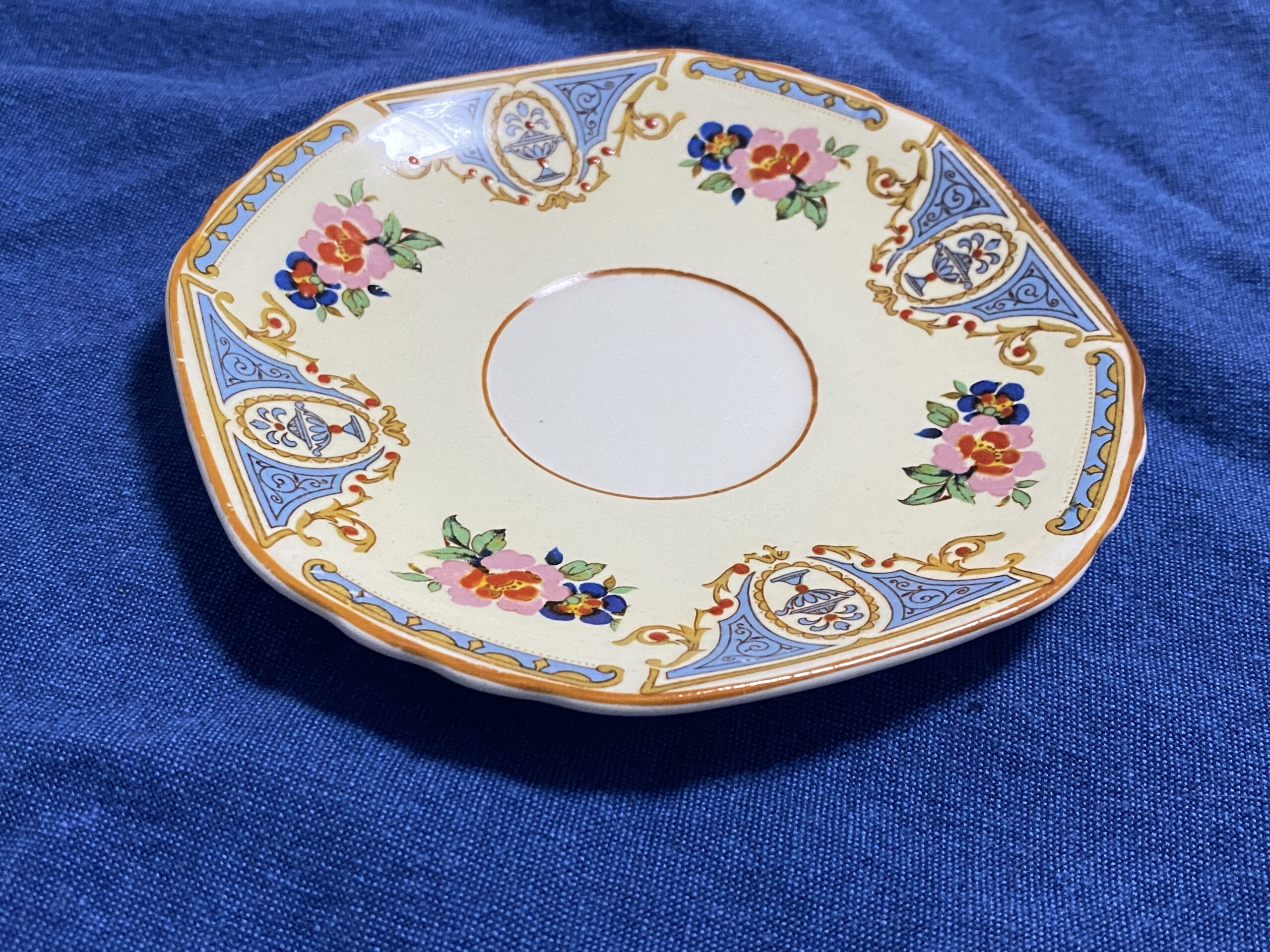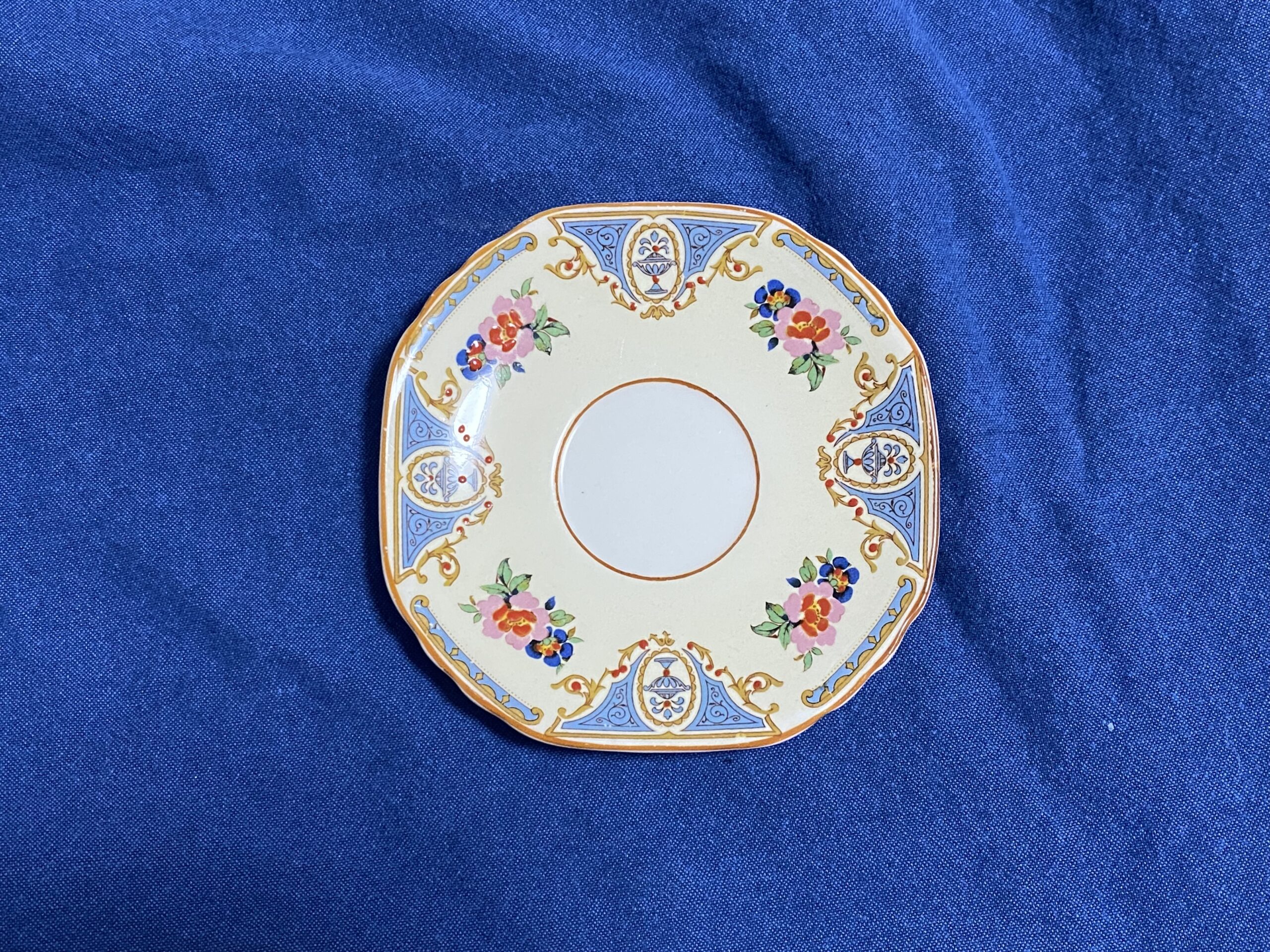XRF Test Results for Wedgwood & Co (Made in England) Chateau Pattern Antique China
March 19, 2023 — Sunday
XRF Test Results for the Dish Pictured
Sent in by a Lead Safe Mama Reader (from Washington State) for Testing
Full test results for these dishes are below. The Lead levels are quite alarming and these dishes should not be used for food purposes.
Some additional reading:
- To read more about the concern for Lead in pottery and china, click here.
- For the menu to this website, where you can look through different categories of items Lead Safe Mama, LLC has tested, click here.
- To see XRF test results for more pieces “Made in England” we have tested, click here.
- To see more Wedgwood pieces we have tested, click here.
- To learn more about sending in an item from your home for testing by Lead Safe Mama, LLC — click here.
Color-Code Key to XRF Readings Below
Metals noted in RED are considered toxic heavy metals in most applications.
Metals noted in BLUE are not considered toxic in this application.
Metals noted in GRAY were not found to be present (with the low threshold of detection for the XRF instrument normally falling in the single or double-digit ppm for most metals).
Reading #1) Center Of Food Surface of Dish (White Area)
60-second test (repeated multiple times to confirm results)
- Lead (Pb): 66,500 +/- 1,500 ppm
- Cadmium (Cd): non-detect
- Tin (Sn): non-detect
- Mercury (Hg): 68 +/- 35 ppm
- Selenium (Se): non-detect
- Barium (Ba): non-detect
- Chromium (Cr): non-detect
- Antimony (Sb): non-detect
- Copper (Cu): non-detect
- Zinc (Zn): non-detect
- Zirconium (Zr): non-detect
- Iron (Fe): 890 +/- 138 ppm
- Vanadium (V): non-detect
- Indium (In): non-detect
- Platinum (Pt): non-detect
- Cobalt (Co): non-detect
- Bismuth (Bi): non-detect
- No other metals were detected in consumer goods mode.
Reading #2) Food Surface of Dish — Cream Area
60-second test (repeated multiple times to confirm results)
- Lead (Pb): 56,200 +/- 1,300 ppm
- Cadmium (Cd): non-detect
- Tin (Sn): non-detect
- Mercury (Hg): 81 +/- 35 ppm
- Selenium (Se): non-detect
- Barium (Ba): non-detect
- Chromium (Cr): non-detect
- Antimony (Sb): 33 +/- 20 ppm
- Copper (Cu): 57 +/- 29 ppm
- Zinc (Zn): non-detect
- Zirconium (Zr): non-detect
- Iron (Fe): 947 +/- 143 ppm
- Vanadium (V): non-detect
- Indium (In): non-detect
- Platinum (Pt): non-detect
- Cobalt (Co): non-detect
- Bismuth (Bi): non-detect
- No other metals were detected in consumer goods mode.
Reading #3) Food Surface of Dish — Pink and Blue Flowers
60-second test (repeated multiple times to confirm results)
- Lead (Pb): 80,100 +/- 2,200 ppm
- Cadmium (Cd): non-detect
- Tin (Sn): 1,202 +/- 64 ppm
- Mercury (Hg): non-detect
- Selenium (Se): non-detect
- Barium (Ba): non-detect
- Chromium (Cr): 2,238 +/- 384 ppm
- Antimony (Sb): non-detect
- Copper (Cu): 58 +/- 34 ppm
- Zinc (Zn): 1,363 +/- 77 ppm
- Zirconium (Zr): non-detect
- Iron (Fe): 1,989 +/- 203 ppm
- Vanadium (V): non-detect
- Indium (In): non-detect
- Platinum (Pt): non-detect
- Cobalt (Co): 1,204 +/- 128 ppm
- Bismuth (Bi): non-detect
- No other metals were detected in consumer goods mode.
Reading #4) Food Surface of the dish — Blue Decorative Area
60-second test (repeated multiple times to confirm results)
- Lead (Pb): 62,500 +/- 1,500 ppm
- Cadmium (Cd): non-detect
- Tin (Sn): 48 +/- 16 ppm
- Mercury (Hg): non-detect
- Selenium (Se): non-detect
- Barium (Ba): non-detect
- Chromium (Cr): 1,313 +/- 312 ppm
- Antimony (Sb): 91 +/- 22 ppm
- Copper (Cu): non-detect
- Zinc (Zn): 2,454 +/- 100 ppm
- Zirconium (Zr): non-detect
- Iron (Fe): 2,757 +/- 211 ppm
- Vanadium (V): non-detect
- Indium (In): non-detect
- Platinum (Pt): 410 +/- 131 ppm
- Cobalt (Co): 1,295 +/- 124 ppm
- Bismuth (Bi): non-detect
- No other metals were detected in consumer goods mode.
In Conclusion
I would not consider these dishes safe for use with food. I am not only concerned with the incredibly high levels of Lead in the food surface glazes (both the white and the cream), but I am also quite concerned with the trace levels of Mercury in these cream-colored and white glazes on the food surface. I always encourage people who have family heirlooms like this to consider framing one dish in a shadow box along with a story about the person to whom it originally belonged — as a keepsake (and perhaps gifting one to each family member). But do not use them for dining (even occasionally).
If you have these dishes, vintage Wedgwood — or, for that matter any other vintage china that may have high-Lead glaze (you can look them up on this link or by typing the brand name into the search bar at the top of any page on this website) — and if you have been using them as your everyday dishes you may want to consider asking your doctor about getting a Blood Lead Level (BLL) test to rule out any potential exposure. Here’s a link with more information about BLL testing. Given BLL testing tends to show immediate recent exposure (there is a 30 to 45-day half-life of Lead in the blood), if you are concerned more about long-term exposure ask your doctor about the possibility of getting a hair test or a urine test. Here’s a link with more information about those types of testing. If you are looking for examples of Lead and Cadmium-free dishes to use as alternatives, please check out this link.
For those new to this website:
Tamara Rubin is a multiple Federal-award-winning independent advocate and activist, and a documentary filmmaker. She is the owner and founder of Lead Safe Mama, LLC — a woman-owned small business for consumer goods safety and childhood Lead-poisoning prevention. She is also a mother of Lead-poisoned children, the inspiration for her work [Tamara’s sons were acutely Lead-poisoned in August of 2005]. She was trained and certified to use XRF technology in 2009 — specifically with a focus on testing consumer goods for toxicants.
- Tamara was the parent advocate responsible for finding Lead in the popular fidget spinner toys in 2017.
- In 2022 her work was also responsible for three CPSC product recalls — the Jumping Jumperoo recall (in June 2022), the Lead painted NUK baby bottle recall (in July 2022), and the Leaded Green Sprouts Insulated Stainless Steel Baby Bottles (November 2022).
- In 2023, her work was featured in Consumer Reports Magazine and has already (as of the date of publishing this article) precipitated a product recall for one of “Oprah’s Favorite Things” the Bindle Bottle insulated stainless steel water bottle.
- To see a summary of violation reports filed by Lead Safe Mama, LLC — as well as recent press coverage of our work — please click this link.
The XRF instrument Tamara uses is the same instrument (and same scientific method) used by the U.S. Consumer Product Safety Commission (CPSC) to test consumer goods for toxicants (specifically heavy metals), including Lead, Cadmium, Mercury, Antimony, and Arsenic. All test results reported on this website (LeadSafeMama.com/TamaraRubin.com) are science-based, accurate, and replicable. Items are tested multiple times, to confirm the test results for each component tested and reported on. Please click through to this link to learn more about the testing methodology used for the test results discussed and reported on this website.
Never Miss an Important Article Again!
Join our Email List















Dear Tamara.
Thank you for the service you provide to those of us who have vintage decorative bone china from before 1970, as well as Corelle that you have tested that has come back positive for lead. I can throw away the Corelle or try to sell it to a collector with the caveat that there is lead on the surface. My Corelle cereal bowls tend to explode when they go into the sink, so none in use anymore. The pattern I think is Springflower Green, it is one of the original Corelle patterns. I have two sets of Wedgwood china, both are no longer made. One is called Galaxie White which my mom accumulated mostly pre 1970. The other is Turquoise Florentine which we had almost since I was born in 1953. It is highly decorated and hand painted and hand enameled. A friend in my neighborhood has the same Corelle and the Wedgwood Turqoise Florentine. A funny coincidence. I sent her a link to your website. I also have a small set of Corelle Christmas pieces that I got from in-laws, used, and I am sure that they are pre 1980. I guess I have some shopping to do! My pots and pans are all Revere Ware stainless steel with copper bottoms, from the 1920s or so up to the 1990s. I guess I can try to contact whoever owns that brand now to see if they are safe, as a lot of them have scratches.